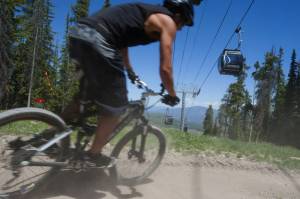Washington, DC – Apparently, summer recreation at U.S. ski resorts is considered an “essential service.”
Despite the U.S. Government budget impasse and shutdown, in the Federal Register on Wednesday the U.S. Forest Service (USFS) published a request for public comment on expanding summer recreation at the 122 ski resorts that operate on National Forest Service (NFS) land. The Forest Service is proposing to revise its directives for ski areas authorized under the National Forest Ski Area Permit Act of 1986 to provide additional guidance for implementing the 2011 amendment to this Act, known as the Ski Area Recreational Opportunity Enhancement Act (SAROEA).
That 2011 amendment, championed by Colorado Democratic Senator Mark Udall, is designed to allow ski resorts located in Arizona, California, Colorado, Idaho, Montana, New Hampshire, New Mexico, Oregon, Utah, Vermont, Washington and Wyoming to offer their guests a wider array of activities in summer, including zip lines, mountain coasters and alpine slides, disc golf, mountain biking and concerts. As originally enacted in 1986, the Ski Area Permit Act only authorized Nordic and alpine skiing at ski areas on NFS lands.

“The Agency recognizes that additional seasonal and year-round recreation activities and associated facilities are important to the long-term viability of ski areas, and that the more managed outdoor recreation settings at ski areas could introduce urban-based population segments, especially youth, to outdoor recreation,” USFS Chief Thomas L. Tidwell wrote in the Federal Register. “This exposure could build a deeper appreciation for nature that could lead to further exploration of NFS lands beyond ski areas. Further guidance on authorization of additional seasonal and year-round recreation activities and associated facilities at ski areas will help permit administrators review proposals for these activities consistent with these objectives and SAROEA.”
Current directives limit the criteria for determining whether additional seasonal and year-round recreation activities may be approved at ski areas operating on USFS land. The proposed directives would add criteria to help officials determine whether proposals for these activities are consistent with SAROEA. The proposed directive also would provide guidance on use of ski areas by the non-paying public for activities such as snowshoeing or cross-country skiing, and would clarify policy regarding advertising.
“Forest Service regulations and ski area permits provide that authorized uses of NFS lands are not exclusive, and that the Forest Service may require common use of the lands or use by others in any way that is not inconsistent with the permit holder’s rights and privileges, after consultation with all affected parties,” Tidwell wrote. “Several ski areas on NFS lands have experienced a significant increase in the number of recreationists using snowshoes or cross-country skis or simply traveling on foot on slopes within ski areas. The Agency has identified a need to address how this type of public use may be conducted efficiently and safely. Consequently, the proposed directives would provide guidance on recreational use at ski areas by the non-paying public.”
Comments must be received in writing by December 2, 2013. Submit comments electronically by following the instructions at the Federal eRulemaking portal at www.regulations.gov — and they’re still accepting comments through the shutdown. Comments also may be submitted by mail to USDA Forest Service Ski Area Comments, Pacific Southwest Regional Office, 1323 Club Drive, Vallejo, CA 94592. If comments are submitted electronically, duplicate comments should not be sent by mail. Hand-delivered comments will not be accepted, and receipt of comments cannot be confirmed.
Officials are asking the public to confine comments to issues pertinent to the proposed directive, explain the reasons for any recommended changes, and, where possible, reference the specific section and wording being addressed. All comments, including names and addresses when provided, will be placed in the record and will be made available to the public for review and copying.

